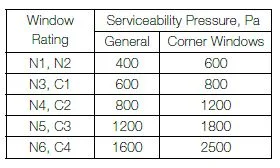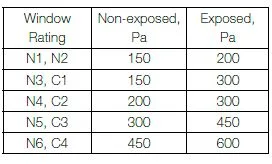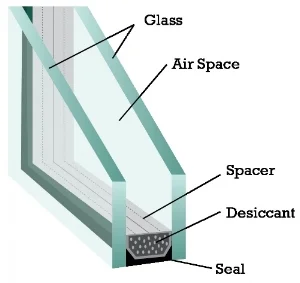Frame Types
We make several types of frames to meet the different sizes and codes required in Australia. If you live in a high bush fire area or a high wind location you will need a thicker and stronger frame.
There is no fixed rule for each city as the exact position and orientation may effect the “N” rating required but as a general rule the following is a guide: For most people who live in NSW, Victoria or Canberra a n1-3 rated window will do. Queensland south of Brisbane is the same however the further north and more coastally exposed the window is the higher the standard you will require due to wind and climate conditions that Frequent your area.
Your architect and engineer should advise you what rating you need for each window.
window pressure n rating table
water penetration rates n classification table
Standard frames
Most window frames are made from aluminium of various thickness and shapes. When choosing windows it is crucial to ask what the thickness of the frame is and ensure the cross section of the profile is well designed. The cheaper ones most likely to fail, are often very thin “cokecan” aluminium lacking in reinforcement, which means it is more likely to leak wind and water into your home.
All of our frames are a minimum of 1.7mm and up to 3.0mm thick. This makes them extremely rigid and stable. Our window frames are further reinforced by the combining of several aluminium box sections . It is this thickness and reinforced cross section that prevents warping or twisting of the frame over time. We are proud to say that our windows will stand up to anything nature can throw at them.
Thermally broken frames
Most widow frames are made of aluminium which is an excellent conductor of heat/cold. This is not so good for a window frame where you want the heat/ cold outside to stay there and not come in. a thermally broken frame is in reality 2 frames with a plastic divider between them. This acts like the air gap in the double glazed widow to help stop that transfer of energy from occurring. Some people advocate PVC window frames for this reason too however PVC frame apart from the aesthetic negatives lack the same rigidity over time that aluminium windows have and as such distort in shape.
Glass Types
When choosing the windows for your project the first and most important thing is it looks good!!! the second is that is helps makes your house comfortable to live in. SO here we teach you a little about the different types of ways we can build those windows or doors to help you achieve that.
Double / Triple glazing
Double glazing refers to when we make the window with 2 panes of glass typically 5-6mm thick with an air gap between. Just like a thermos for your coffee it helps stop the transfer of heat or cool between the outside and inside. when measuring the insulating qualities of a window we will use an “ R value “ or “U value” to demonstrate the difference that it makes.
Triple glazing is as above but we use 3 panes of glass instead of 2. For climates where temperatures drop below zero often or are above 30 degrees often this can be a very good thing as it gives even greater temperature control performance
Low E glass
Low E glass is used in very hot or very cold climates (below zero or above 30 degrees) it works by coating the glass with a microscopic film that filters the light coming in or going out.
If you live in a cold climate we coat the inside pane of a double glazed window with a coating that reflects long wave radiation. This keeps the heat inside. If in a hot climate we coat the outside pane with a coating that reflects short wave solar infrared energy. Thus keeping the heat from even entering your home. This means you still get a bright well lit space without the corresponding gains or losses of heat that single glazing brings.
To summarize here is a chart that shows the corresponding U values of the different glazing products. The lower the number the better the window performs at letting light in but stopping energy transfer through it.
But what does this mean for you and your house?
lets look at an average 5 person household in Canberra with brick cladding and insulation in walls and ceiling.
The average cost of heating / cooling such a house with single glazed windows and a standard reverse cycle airconditioner or ducted gas /electric heater is over $8000 per year [1] This house also suffers from increased condensation on windows in winter and the dry air blowing through the house spreads mites, mould spores, dust. It further dries out the nasal pages of people living in it.
When we replace the single glazed widows with correctly installed double glazed the energy efficacy of the windows improves by over 50%!! Providing your home is insulated correctly this translates to 100’s of dollars a year in savings.
If we use low e glass, thermally break the frames or go up to triple glazing those savings improve by another 50% over double glaze and are at their peak 75% improvement on single glazed windows.
If the house has solar panels on the roof essentially the heating or cooling can be programmed to use this excess day time energy to heat/ cool the house when no one is home so in the evening when you return the temperature inside is perfect! If you have single glazing this energy is wasted through the glass.
We would never think to build a house without insulation these days because of the massive cost in heating and or cooling it. But without at least double glazing the windows the house loses so much heat/ cool all that insulation is wasted . you may as well leave the window open for all the good it does.
[1] Calculations based on AER usage data for 5 people residences (14347KWH) for suburb 2615 and priced against AGL published price lists 28/9/2018.







